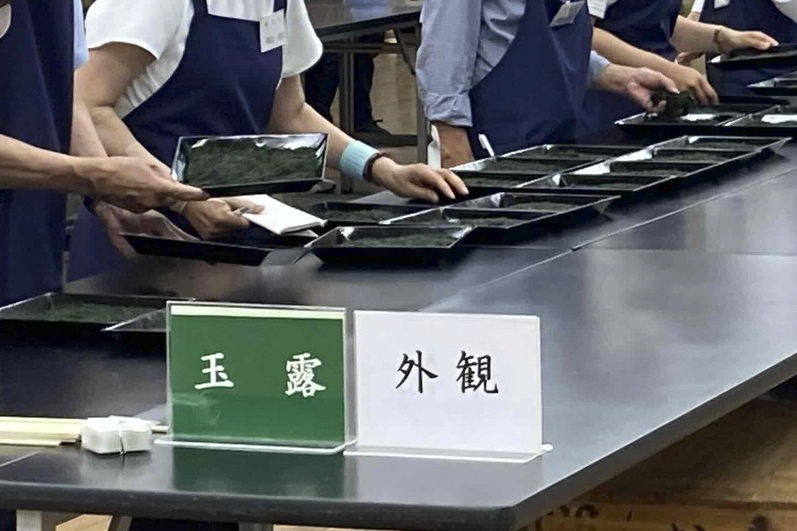In July, as summer heat intensifies, the second harvest of tea is nearing the end. It gives time to evaluate the results. Between 4th-5th July a tea competition was held in Kyoto. 275 samples were submitted to 4 different tea categories: sencha, kabusecha, gyokuro and tencha. Koki Tsuji – a tea producer from Uji got first place in the tencha category, and Hideko Fukui – a tea producer from Ayabe was awarded first place in the kabuse category.
In Kagoshima last month a different kind of competition took place as well – a riding competition of the driven harvesting machines. It was held on 29th June in Chiran Town, Minami Kyushu City and 8 groups from various parts of the city took part. The competition involved two round trips of 100m tea rows. Not only the speed and accuracy but also the safety of the operation were evaluated.
While not as well known as Uji tea from Kyoto or Kakegawa tea from Shizuoka, recently Chiran tea has been growing in popularity. The local producers are especially focusing on organic tea production and have formed a partnership with a large supermarket chain for bottled tea sales. Additionally, to raise the visibility of Chiran tea, Minami-Kyushu City Tea Industry Promotion Association is organizing the Chirancha Ambassador program again, that will take place in August.
Ehime Prefecture is also trying to keep alive the production of the old regional tea – Ishizuchi Kurocha, by involving highschool students. In March Ishizuchi Kurocha was designated as an Important Intangible Folk Cultural Property of Japan. Since 2016 the prefectural agricultural highschool has been working with three local organizations to preserve and pass down the production methods of this unique tea. Students learn not only the tea production methods, but also how to incorporate it into sweet making.
In Saitama, the fallen leaf compost farming method (落ち葉堆肥農法) has been certified by the United Nations Food and Agriculture Organization (FAO) as a Globally Important Agricultural Heritage System. The method has been passed down for 300 years. It has helped to soften the soil and Saitama has become a leading producer of sweet potatoes and tea.
For enjoying the tea, a space is important, but very few know of the tea room in Uji City hall. After the creation of a tea room in Kyoto city hall has been criticized as wasteful, some noticed that the tea room in Uji City hall was also little known to citizens and employees. Located on the 7th floor of the building it does not draw the eye.
What draws the eye is a simple portable tea room made of bamboo. It consists of 30 sticks of 2m bamboo and can be easily assembled and disassembled. The tea room is called Kian and was created by the chief priest of the Daiji-in temple in Daitoku-ji Temple. It has already been to various locations around Japan and abroad.
To support the reconstruction of Mabi city in Okayama, that was damaged by heavy rain in 2018, Kyoko Takahashi has convinced bamboo tea utensils makers in Nara to use Mabi grown bamboo. The quality of Mabi bamboo was highly praised by the Nara craftsment.
Recently there also have been many developments in the bottled tea sphere. Fukuroi City, Shizuoka Prefecture has recently launched its bottled hojicha. At the beginning of the year 4 different recipes were tested with the locals and the most popular one was commercialized. Recently a new partnership was also formed between ItoEn and 7 Eleven, that produced bottled tea with leaves from Shibushi City. It uses Saemidori cultivar and tries to draw attention to lesser known tea cultivars in Japan. Bottled tea from Kameyama City in Mie Prefecture has also been resurrected recently. With the focus on the use for corporate events, the production was discontinued during the pandemic. However, recently it was resurrected with the new focus on individual tea drinkers.
It is wonderful to see various new developments in the tea industry.
The article is based on the Japanese media articles:
- Shibushi tea “Saemidori” to go nationwide, developed by Itoen and Seven, featuring sweetness, Asahi Shimbun 2023.07.07
- Winners of the Uji Prefectural Tea Competition selected based on aroma, color and taste, Mainichi Shimbun 2023.07.07
- Eight pairs compete in the time and safety “skills” of tea picking with a riding tea-picking machine, Asahi Shimbun 2023.07.07
- Bamboo from Mabi, her hometown, is used for tea ceremony utensils, Yomiuri Shimbun 2023.07.08
- Fallen Leaf Composting Agricultural Method Recognized as World Heritage in Saitama and Musashino Areas, Mainichi Shimbun 2023.07.11
- Hidden teahouse in Uji City Hall, Kyoto, unknown to even the employees, Kyoto Shimbun 2023.07.12
- Bamboo mats can be carried anywhere as a tea ceremony room, a space for quiet conversation invented by a Kyoto priest, Asahi Shimbun 2023.07.12
- Chiran tea “is actually the best in Japan,” to improve its name recognition by fostering fans and organics, Nikkei Shimbun 2023.07.13
- Kameyama Tea” revival is going strong, with emphasis on cool, easy-to-drink PET bottles for individuals, Yomiuri Shimbun 2023.07.15
- Aiming for branding, Fukuroi hojicha, 100% locally grown, PET beverage on sale, Asahi Shimbun 2023.07.16
- Golden “Two-Step Fermentation” Tea: High School Students in Ishizuchi Mountain Range Become the Next Generation of Tea Leaders, Mainichi Shimbun 2023.07.28
*Image source: Uji City Tea Production Association

